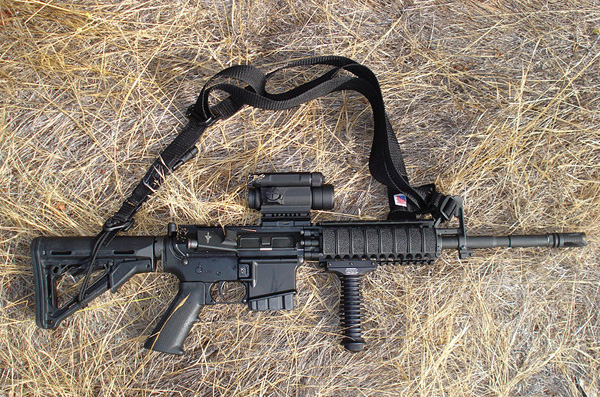
Photo by: Igor
An AR-15-style rifle. Different companies make distinct versions of the weapon, the best known of which is the Colt M-16—which is only made for military use.
If it sometimes seems that advocates and opponents of gun control are speaking different languages, it’s because they are—at least when it comes to what to call the kind of gun that Adam Lanza used to slaughter schoolchildren and staff in Newtown, Conn.
Gun control advocates tend to call these guns “assault weapons” or “assault rifles.” To wit, “The Brady Campaign supports banning military-style semi-automatic assault weapons along with high-capacity ammunition magazines,” notes the website of the gun control group named after the White House aide wounded in the 1981 attempt to assassinate President Reagan. And the 1994 ban on such guns was called “The Assault Weapons Ban.”
The gun lobby never liked the ban—which expired in 2004—or the nomenclature. The National Shooting Sports Foundation, which represents the gun industry, insists that rifles like the Bushmaster .223 that Lanza used “are NOT ‘assault weapons’ or ‘assault rifles.’ An assault rifle is fully automatic—a machine gun. Automatic firearms have been severely restricted from civilian ownership since 1934. If someone calls an AR-15-style rifle an ‘assault weapon,’ he or she either supports banning these firearms or does not understand their function and sporting use, or both. Please correct them. ‘Assault weapon’ is a political term created by California anti-gun legislators to ban some semi-automatic rifles there in the 1980s.”
The term “AR-15” has been attached to these weapons since they were developed decades ago—even before the military bought the guns and called them M-16s. “AR” looks like it stands for “assault rifle” or “automatic rifle” but it actually stands for “ArmaLite rifle,” after the company that first developed the design.
An “automatic rifle” would shoot multiple bullets with a single trigger pull; it’d be a machine gun and those are illegal for private citizens to own unless they get special government permission. The Bushmaster is semi-automatic, meaning you need to pull the trigger for each bullet you fire. It’s “semi-automatic” because every shot that’s fired advances the next bullet into the chamber. You don’t need to manually re-cock the gun after each shot, as you might with some bolt-action or lever-action rifles.
So, the AR-15 is not an “automatic” rifle. Whether it is an “assault weapon” depends on whether a gun has to be automatic to be an assault weapon. And that depends on whom you ask. Laws about “assault weapons” have often focused as much on their appearance—like whether they have a bayonet mount or a pistol grip—as their firing capability.
Whatever you call them, these guns are big sellers. The $38 billion-a-year gun industry has enjoyed enormous growth during the Obama administration, and rifles—including modern-sporting/assault rifles—are a big part of that. U.S. gun makers used to produce 1.5 million or so rifles a year, but now they’re regularly over the 2 million mark. Not all of those are “modern sporting rifles” but a lot are.
Guns manufactured for domestic use or imported to the U.S., 1986-2011
Freedom Group, the company that owns the country’s biggest rifle maker, Remington, and several other gun-makers, this fall reported third quarter sales of $130.3 million, nearly 25 percent more than the same period last year. “In many areas, the market is expanding quicker than the industry can increase production. Accordingly, our company is experiencing strong demand for modern sporting firearms and handguns, as well as above capacity demand levels for more traditional hunting and target shooting platforms,” the company said in its earnings report. “Further, we believe the adoption of the modern sporting rifle has led to increased long-term growth in the long gun market while attracting a younger generation of shooters.”
Smith & Wesson, another major publicly-traded gun-maker, reported third-quarter sales of modern sporting rifles that more than doubled over the third quarter of 2011, from $14 million to $31 million.
The beauty of AR-15-style guns, for the gun industry, is that they have a modular configuration. Owners can add scopes and other gizmos, change the style of stock they use and modify the gun in other ways. Those parts and add-ons are a very lucrative business, both for gun-makers and firms that focus solely on the accessories.
As we reported this summer, the business side of the gun issue often gets overlooked as everyone focuses on the cultural dimension of the topic. The gun industry will be a big player in any post-Newtown debate. And it could play a complex role. Not surprisingly, it provides a lot of financial support to the National Rifle Association, and resists gun control because it cuts into profits.
But since profits—not controversy or politics—is what concerns gun manufacturers, they don’t always see eye-to-eye with the gun lobby. Sometimes gun-makers have accepted such extensive government oversight that the gun lobby has boycotted them. Smith & Wesson, for instance, agreed to voluntary restrictions in 2000.
That was in the aftermath of another school shooting, at Columbine, that folks thought was going to change everything.
City Limits’ gun reporting has been supported by The Investigative Fund at The Nation Institue.
Correction: The original story referred to the sales reported by the Remington Arms company when, in fact, these were the sales reported by Freedom Group, which owns Remington and other weapons manufacturers.







